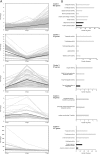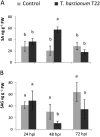Transcriptome reprogramming, epigenetic modifications and alternative splicing orchestrate the tomato root response to the beneficial fungus Trichoderma harzianum
- PMID: 30603091
- PMCID: PMC6312540
- DOI: 10.1038/s41438-018-0079-1
Transcriptome reprogramming, epigenetic modifications and alternative splicing orchestrate the tomato root response to the beneficial fungus Trichoderma harzianum
Abstract
Beneficial interactions of rhizosphere microorganisms are widely exploited for plant biofertilization and mitigation of biotic and abiotic constraints. To provide new insights into the onset of the roots-beneficial microorganisms interplay, we characterised the transcriptomes expressed in tomato roots at 24, 48 and 72 h post inoculation with the beneficial fungus Trichoderma harzianum T22 and analysed the epigenetic and post-trascriptional regulation mechanisms. We detected 1243 tomato transcripts that were differentially expressed between Trichoderma-interacting and control roots and 83 T. harzianum transcripts that were differentially expressed between the three experimental time points. Interaction with Trichoderma triggered a transcriptional response mainly ascribable to signal recognition and transduction, stress response, transcriptional regulation and transport. In tomato roots, salicylic acid, and not jasmonate, appears to have a prominent role in orchestrating the interplay with this beneficial strain. Differential regulation of many nutrient transporter genes indicated a strong effect on plant nutrition processes, which, together with the possible modifications in root architecture triggered by ethylene/indole-3-acetic acid signalling at 72 h post inoculation may concur to the well-described growth-promotion ability of this strain. Alongside, T. harzianum-induced defence priming and stress tolerance may be mediated by the induction of reactive oxygen species, detoxification and defence genes. A deeper insight into gene expression and regulation control provided first evidences for the involvement of cytosine methylation and alternative splicing mechanisms in the plant-Trichoderma interaction. A model is proposed that integrates the plant transcriptomic responses in the roots, where interaction between the plant and beneficial rhizosphere microorganisms occurs.
Conflict of interest statement
The authors declare that they have no conflict of interest.
Figures








References
-
- Lopez-Bucio, J., Pelagio-Flores, R. & Herrera-Estrella, A. Trichoderma as biostimulant: exploiting the multilevel properties of a plant beneficial fungus. Sci. Hortic.196 109–123 (2015).
-
- Shoresh, M., Harman, G.E. & Mastouri, F. Induced systemic resistance and plant responses to fungal biocontrol agents. Annu. Rev. Phytopathol.48, 21–43 (2010). - PubMed

